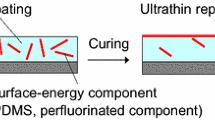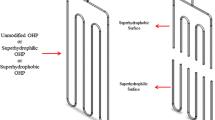Abstract
Frost formation occurs when water vapor in the surrounding air comes into contact with cold surfaces through heat and mass transfer. It is usually an undesirable phenomenon in most refrigeration and cryogenic systems. A few studies have shown that changing the surface energy, such as increasing the surface hydrophilicity or hydrophobicity, has significant effects on frost growth. In this paper, a kind of hydrophilic polymer paint is formulated to counteract frost deposition on cold surfaces. The coated surface can retard frost formation up to three hours under low plate temperatures (− 15.3°C) and high air humidity (72%). To test the antifrosting performance of the hydrophilic paint under more practical conditions, it is applied to a fin-and-tube heat exchanger and a domestic refrigerator at a coating thickness of 30 μm. Comparisons of frost deposition, pressure drops, and outlet temperatures are made between uncoated and coated heat exchangers. Under conditions of high air temperature (2.2°C) and relative high air humidity (90%), the paint prolongs the defrosting interval from 80 to 137 min. Experimental observations also show that the coated hydrophilic fins are free of frost deposition during the entire course of the test and that the coating has no significant additional thermal resistance.
Similar content being viewed by others
References
Emery A F, Siegel B L. Experimental measurements of the effects of frost formation on heat exchanger performance. Proceedings of AIAA/ASME Thermo physics and Heat Transfer Conference, 1990, 139: 1–7
Sahin A Z. Effective thermal conductivity of frost during the crystal growth period. International Journal of Heat and Mass Transfer, 2000, 43(4): 539–553
Hayashi Y, Aoki A, Adachi S, Hori K. Study of frost properties correlating with frost formation types. Journal of Heat Transfer, 1977, 99: 239–245
Cheng C H, Cheng Y C. Prediction of frost growth on a cold plate in atmospheric air. International Journal of Heat and Mass Transfer, 2001, 28(7): 953–962
Na B, Webb R L. New model for frost growth rate. International Journal of Heat and Mass Transfer, 2004, 47(5): 925–93
Gupta J K, Gopal M R, Chakraborty S. Modeling of a domestic frost.free refrigerator. International Journal of Refrigeration, 2007, 30(2): 311–322
Fossa M, Tanda G. Frost formation in vertical channels under natural convection. International Journal of Multiphase Flow, 2010, 36(3): 210–220
Okoroafor E U, Newborough M. Minimising frost growth on cold surface exposed to humid air by means of cross linked hydrophilic polymeric coatings. Applied Thermal Engineering, 2000, 20(8): 737–758
Liu Z L, Wang H Y, Zhang X H, Meng S, Ma C F. An experimental study on minimizing frost deposition on a cold surface under natural convection conditions by use of a novel anti-frosting paint. Part I: Anti-frosting performance and comparison with the uncoated metallic surface. International Journal of Refrigeration, 2006, 29(2): 229–236
Liu Z L, Zhang X H, Wang H Y, Meng S, Cheng S Y. Influences of surface hydrophilicity on frost formation on a vertical cold plate under natural convection conditions. Experimental Thermal and Fluid Science, 2007, 31(7): 789–794
Liu Z L, Wang H Y, Zhang X H, Meng S, MA C F. An experimental study on minimizing frost deposition on a cold surface under natural convection conditions by use of a novel anti-frosting paint. Part II: Long-term performance, frost layer observation and mechanism analysis. International Journal of Refrigeration, 2006, 29(2): 237–242
Incropera F P, Dewitt D P. Fundamentals of Heat and Mass Transfer. 5th ed. New York: Wiley, 2001
Kondepudi S N, O’Neal D L. Frosting performance of tube fin heat exchanger with wavy and corrugated fins. Journal of Experimental Thermal and Fluid Science, 1991, 4(5): 613–618
Min J C, Webb R L, Bemisderfer C H. Long-term performance of dehumidifying heat-exchangers with and without hydrophilic coatings. International Journal of Heating, Ventilating, Air-Conditioning and Refrigerating Research, 2000, 6(3): 257–272
Yoshiyuki T, Akiko I. Anti-frosting heat exchanger. National Technical Report, 1992, 108–113
Ryu S G, Lee K S. A study on the behavior of frost formation according to surface characteristics in the fin-tube heat exchanger. J Air-Conditioning and Refrigerating, 1999, 11(3): 377–383 (in Korean)
Huang L Y, Liu Z L, Liu Y M, Gou Y J, Wang J T. Experimental study on frost release on fin-and-tube heat exchangers by use of a novel anti-frosting paint. Experimental Thermal and Fluid Science, 2009, 33(7): 1049–1054
Highgate D, Knight C, Probert S D. Anomalous “freezing” of water in hydrophilic polymeric structures. Applied Energy, 1989, 34(4): 243–259
Author information
Authors and Affiliations
Corresponding author
Rights and permissions
About this article
Cite this article
Liu, Z., Huang, L., Gou, Y. et al. Experimental investigations of frost release by hydrophilic surfaces. Front. Energy Power Eng. China 4, 475–487 (2010). https://doi.org/10.1007/s11708-010-0114-x
Received:
Accepted:
Published:
Issue Date:
DOI: https://doi.org/10.1007/s11708-010-0114-x




